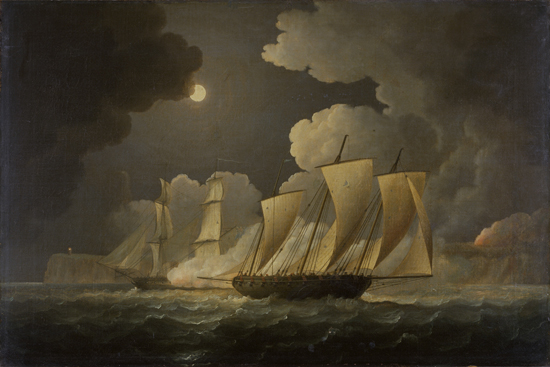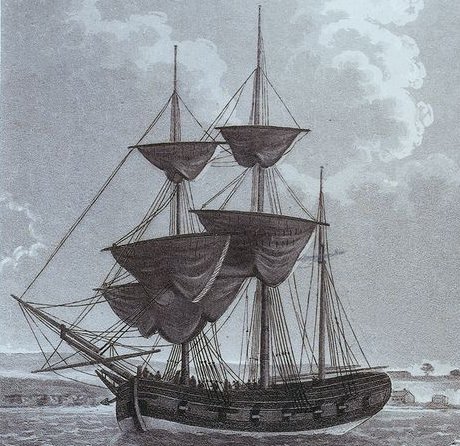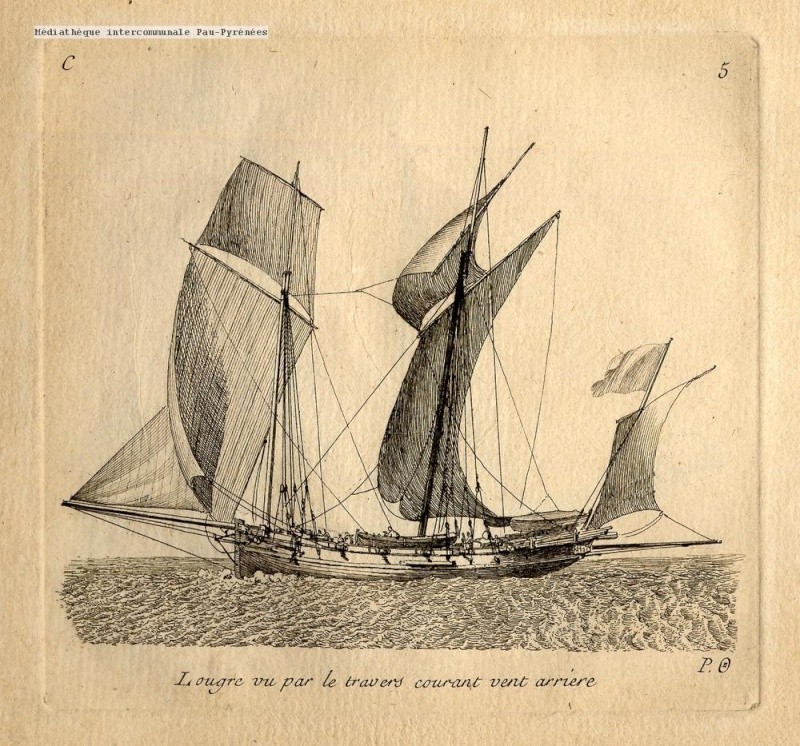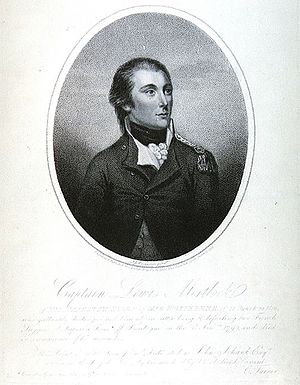Privateer Action in the English Channel, 1793 & 1799
Probably like many others I have always thought of privateers in the Age of Fighting Sail as preying on enemy merchant shipping on commercial routes in open ocean, far from land. My perception has however been changed by an 1889 book, “Betwixt the Forelands”, by the Victorian maritime author W. Clark Russell, in which he deals with the naval history of the English Channel from the Middle Ages onwards. At its narrowest, this strait between the English and French coasts is only some twenty miles wide, and domination of it was always a key objective of British naval policy. It was – and is – one of the busiest commercial waterways in the world, offering access to Northern Europe from the Central Atlantic. Clark Russell’s book highlights the fact that, though Britannia might rule the waves and dominate the Channel, the prize of rich commercial pickings was always an inducement for French privateers in light craft to dart out, seize their prizes and retire quickly to the cover of their well-defended home ports. The story of one such foray tells just how savage these encounters could be.

“British brig attacking a French lugger” by Thomas Buttersworth (1768-1842)
Tensions between Britain and Revolutionary France had escalated through 1792. Following the execution of the French King Louis XVI on 21st January 1793 Britain expelled the French ambassador and on 1 February France responded by declaring war on Great Britain. The period of the Revolutionary and Napoleonic Wars, which were to last until 1815, with a break of only a few months, had begun. Within days of the declaration the crew of a British merchant ship, the Glory, was to be one of the first victims of the war at sea, and indeed at its most cruel. Under a Captain Benson she had just cleared the South Foreland and its White Cliffs, just north-east of Dover, when a French privateer bore down upon her. An attempt to flee failed and the French vessel sent a boat across with fifteen armed men. What followed was atrocious. According to Clark Russell Benson was “seized, bound hand and foot, and lashed down upon a chest. His crew was clapt in irons, plundered of every article, and insulted by every injurious terms the Johnnies could lay their tongues to” (It is notable that in this period the French were referred to as ”Johnnies”).

Sir Samuel Hood
The French were now preparing to run their prize back home – Calais was twenty miles away, the great base at Dunkirk just twice that – but now retribution arrived in the form of the 32-gun frigate HMS Juno, en-route to the Mediterranean and commanded by the future Vice-Admiral Samuel Hood (1762 – 1814), a cousin of the more renowned admiral of the same name. There could be no contest, no hope of escape, and the French surrendered without further ado.
It is what followed which was perhaps most interesting, and I quote below from the statement made by the Glory’s Captain Benson, as repeated by Clark Russell:
After his ship had been boarded and his crew put in irons Benson claimed that the Frenchmen “led me down to my cabin, where they placed me on my back, and lashed me to my chest by my neck, arms and legs, with my head hanging over. I was in the most excruciating pain for four hours and a half. In this helpless condition the cowardly miscreants (they disgrace even the name of Frenchmen) snapped a pistol at my head, and another made a thrust at me with a cutlass, which fortunately went off at an oblique direction through my coat and jacket.” Worse was to follow. “They cut off my dog’s head, they said, for the purpose of representing the fate of the whole crew when we got to France.”
As the Juno drew near the French released their prisoners – it would have been unwise for the French to be found with their captives so cruelly trussed up. Benson was however little inclined to forgive and forget and, as he remarked, “It is difficult at all times to keep the passions within a due state of subordination.” He accordingly snatched a cutlass from the hand of the French seaman who untied him and “I almost at one stroke severed his left hand from his body; when, fearing for the further effects of my frenzy, he jumped out of the cabin window and was drowned. Another followed his example. And jumped off the taffrail, and the (French) captain, dreading the just vengeance which was awaiting him, took a pistol and shot himself through the head.”

Thomas Buttersworth – a Royal Navy brig chasing a privateer
Benson’s “frenzy” was still unsatisfied: “I was not yet reduced to reason and, before the Juno’s crew could overpower me, had cut and lacerated three more of the Frenchmen so dreadfully that they were now entirely covered with blood, and now lie in the hospital without any hope of recovery.”
It is possible that today Benson would be hauled before a court to answer for violation of the Human Rights of his persecutors. His era was however a more robust one and he ends his statement: “Those only who suffer can feel, and, though the more moderate part of mankind my blame me for rashness, my own heart acquits me of any deliberate or unprovoked act of cruelty.”
Even at this very early stage of the conflict that was to last almost twenty-two years, the naval warfare in the “Narrow Seas” between Britain and the European coastline was to be of a quite savage nature, not unlike the battles that were to be fought by British and German coastal forces in the same waters in World War 2. The pace of action was not to let up in the years that followed as French privateers, often of very small size, darted out to prey on British coastal traffic and retired quickly to well-defended bases such as Calais. The war against them was to be waged not by the mighty battle-fleets or their supporting frigates but by small handy craft such as brigs and cutters, heavily armed for their size. A further instance of such combat occurred in 1799, as follows.

HMS Wolverine,1798 – her rounded bows betray her civilian origin
HMS Wolverine was a civilian-owned collier before being purchased by the Royal Navy in 1798 for conversion to an armed brig. Her armament was powerful – only two of her guns were long 18-pounders and her others were all carronades, six of them 24-pounders and six 12-pounders. The carronades were murderously efficient weapons at short range and gave a craft such as the Wolverine a “punch” out of all proportion to their size. She was to see service immediately after commissioning by Commander Lewis Mortlock when she supported a “Dieppe 1942” type raid on the port of Ostend. On January 3rd 1799 she was cruising off the French port of Boulogne, some twenty miles from the English coast. Weather conditions were poor but two large French armed luggers were spotted. These were later identified as the fourteen-gun Le Furet and the eight-gun Rusé, all weapons being four-pounders. Their combined crews were roughly four times the 70 men carried by Wolverine – a potentially decisive factor should it come to boarding. These were typical privateers of the English Channel and such craft usually fled from confrontation with naval units – their objective was capture of rich commercial prizes rather than combat – and Mortlock realised that to bring them to action it would be necessary to play the role of a merchantman, a ruse that Wolverine’s civilian lines would assist. He accordingly hoisted Danish colours and, as expected, the luggers bore down on him and hailed. Asked for his identity, Mortlock answered that he was en-route from Plymouth to Copenhagen. All his guns were manned, their crews out of sight and to all appearances Wolverine looked like an unarmed and attractive commercial prize.

An armed French lugger of the period – Le Furet and Rusé possibly looked similar
Mortlock’s deception paid off. As the unsuspecting Le Furet drew close, British colours were run up in place of the Danish and a full broadside unleashed. Given the disparity in firepower the only French hope now lay in boarding. Le Furet accordingly ploughed on towards Wolverine’s starboard quarter and crashed her bowsprit between the mizzen-shrouds and the mast while small-arms fire were poured on to her decks from the British tops. Close on Le Furet’s heels the Rusé came in on Wolverine’s port bow. From both luggers French boarders now poured across and Wolverine’s gunners had to abandon their weapons to join in the close combat on deck. The four-to one disparity in crew numbers was firmly in favour of the French and the fighting was now of a close, hand to hand, nature. According to Russell’s account, one Frenchman in particular “was observed to be cheering his men and beating them forward with the flat of his sword. The plucky rascal sprung to the top of the round house, where he stood hysterically yelling to his people and flourishing his weapon. Mortlock, supposing him to be the captain of the privateer, rushed at him. The Frenchman snapped a pistol in his face; it missed fire; he drew out another pistol but before he could level it Mortlock had plunged his half-pike into his body and he went overboard.” The resistance seems to have been so resolute that the French did not press their advantage with any great enthusiasm. A diversion was created by men from Le Furet throwing bags full of incendiary material through Wolverine’s stern windows and starting a fire. This drew the British crew away to fight the conflagration and in the confusion the French boarders withdrew, cut the lashings that bound their luggers to the Wolverine, and made off. Wolverine, scarred but triumphant, retired to Portsmouth.

Lewis Mortlock – young, handsome and doomed
Reading of such close actions one is often struck by how light the casualties could be. Wolverine lost two men, one of them Commander Mortlock, who had been badly wounded. He died in his mother’s arms a week later and his funeral was attended by every captain then in Portsmouth. A touching footnote is that his Newfoundland dog, who had been on board Wolverine throughout the action, survived unscathed. French losses were heavier – a total of nineteen killed or dying of wounds shortly afterwards, plus many wounded who survived. Among the dead were Le Furet’s captain – possibly the “plucky rascal” whom Mortlock had slain – and three officers from the Rusé. The disproportion in losses may be partly explained by the surprise Wolverine unleashed on her unsuspecting attackers and another factor is almost certainly that the British crew’s stricter discipline and better training made them more effective than the privateersmen.
Commander Lewis Mortlock’s name is a forgotten one today, yet he was one of the thousands of brave, promising, splendid men whose professionalism was to save Britain and Europe from French domination. We owe him, and those like him, a debt.
